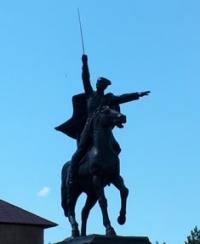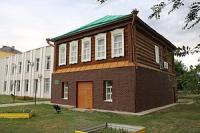You are here
Trip to museums "Khan-Ordasy".


Tours to West Kazakhstan region.
“Nothing of the brilliant constellation of folk talents shown during the decade can be compared with the art of an 80-year-old dombra player from Kazakhstan, a wonderful student of Kurmangazy. The impact of improvisation is irresistible, bewitching. The virtuoso skill she achieved on the dombra is fantastic. What kind of tricks does this wonderful performer use, what kind of timbres she does not extract from an ancient instrument!
The dombra is not pressed to the body, but takes off with his hands, flinching simultaneously with the fingering of amazing fingers. The large hall of the Tashkent Opera House was filled with the sounds of such a seemingly intimate instrument: this is the power of Dina's amazing talent, penetrating into the very secrets of the dombra and making it sound with such expressiveness."
A. Ostrovsky.
Tours to museum complex of the Bokeyorda Khanate.
Brief description of route of excursion walk through villages of West Kazakhstan region:
Uralsk - Chapaev - Shangala - Khan-Ordasy.
Distance of route: 1066 km.
Season: all year round.
Best time for an excursion: May - August.
Duration of trip: 3 days.
Detailed program of excursion to the museum complex of Bokeyorda Khanate:
Day 1. Transfer: Uralsk - Khan-Ordasy settlement (533 km).
Transfer: Uralsk - Bolshoi Chagan village - Budarino village - Chapaev (135 km).
Arrival to Chapaev. The settlement of Chapaev was founded at the end of the 19th century as an outpost “Sundai” on the right bank of the Ural River, later it was renamed into the village “Lbischensk”. Since 1862 it has been the Kalmykovskaya fortress at the middle distance of the Ural Cossack army.
Place of death of the participant of the Civil War V.I.Chapaev (1919). In 1939 the village was renamed Chapaev. In 1997, Chapaev, during the unification of the Chapayevsky, Akzhaik and Taipak districts, became the regional center of the Akzhaik district.
Visit to Chapaev Museum. The memorial museum of the hero of the civil war V.I. Chapaev is located in the village of Chapaev. Visiting of museum. The museum was founded in 1927 in the building where the headquarters of the 25th rifle division was located in 1919 in the former village of Lbischenskaya.
The museum complex includes a stele at the alleged place of death of the legendary commander, as well as a mass grave of the Red Army soldiers who died during the battle with the Ural Cossacks on September 5, 1919.
The museum complex is included in the list of monuments of history and culture of Kazakhstan of republican significance. More than 2,000 exhibits are located in the 5 halls of the memorial complex. The former divisional headquarters has acquired its original form.
On the first floor of the museum there are offices of political workers and the headquarters officer in their original form. Here you can also see a samovar, a cast-iron cauldron where potatoes, tea accessories were cooked, the “Maxim” machine gun that took part in the battles for the village “Lbischensk”.
On the second floor of the museum there are exhibits and information about the hero of the Civil War V.I. Chapaev, his writing desk, wall clock, kerosene lamp, pen and ink. The expositions of the museum also tell about veterans and participants of the Great Patriotic War of 1941 - 1945, prominent figures of the Urals - O. Isaev, H. Esenzhanov, poets and writers - Zh. Moldagaliev, A. Baktgereeva and many others.
A special place in the expositions is given to the Heroes of the Soviet Union - M. Abdolov, E. Orakbaev, A. Shurikhin, T. Masin and N. Maidanov.
Further transfer: Chapaev village - Kyzyloba village - Zhangala village (132 km).
Arrival in the village of Zhangala. Zhangala village (kaz. Zhagagala), administrative the center of the Zhangalinsky region of the West Kazakhstan region of Kazakhstan. In 2011, in the regional center of Zhanakal, a monument to Dina Nurpeisova was erected.
Visit to the Museum of Art History named after Zina Nurpeisova. In 1991, in the village of Zhanakala, in the administrative center of the Zhangalinsky district of the West Kazakhstan region, to the 130th anniversary of the master of the Kazakh dombra Dina Nrupeisov, the Museum of Art History named after Dina Nurpeisova was organized and opened.
The museum is located in an old building, which was built in 1972, until some time it housed the children's library of the village. In 2008, the Museum of Art History in Zhanakala, was reorganized into a branch of the West Kazakhstan Regional Museum of History and Local Lore.
The museum consists of 3 halls; here you can see exhibits, some of which belonged to Dina Nurpeisov, for example, a copy of a camisole. The museum contains exhibits by Dina Nurpeisova of other kuishi composers who were born in the Zhangalinsky region.
These are Kurmangazy, Seytek, Okap, Kali, as well as T. Shamelov and Sh. Kazhygaliev and many others. You can see their personal belongings, musical instruments, photographs. The fund of the museum contains about 1,500 exhibits and over 700 copies of photographs, documents, maps, folk musical instruments.
Further transfer: Shangala - Masteksai village - Novaya Kazanka village - Uyaly village - Bisem village - Khan-Ordasy (Urda) settlement (266 km).
Arrival to the village of Khan-Ordasy. Khan Ordasy (Kaz. Khan Ordasy, until February 18, 2006 Urda, before the revolution Khan Headquarters, from 1922 - Urda, until January 7, 1929 had the status of a city - a village in the Bokeyordinsky district of the West Kazakhstan region ..
It is located 54 km southeast of the village of Saykhin, the administrative center of the Bokeyorda region. The distance from Uralsk to the village of Khan-Ordasy is 533 kilometers. The village is located at the northern end of the Seven Sisters and Zhaskuskum sands and the northwestern outskirts of Ryn-Peski.
To the west of the village is the Salt Mud (Khaki) salt marsh. Transfer to hotel, accommodation, overnight.
Day 2. Khan-Ordasy village - Shangala village (266 km).
Breakfast. Excursion to the museum complex of the khan's headquarters "Bokey Ordasy".
The complex of the khan's headquarters "Bokey Ordasy" dates back to 1801 and is located in the village of Khan-Ordasy in the Bokeyordin district of the West Kazakhstan region. In 2001, the West Kazakhstan region celebrated the 200th anniversary of the Bukeevsk Horde and the 200th anniversary of Zhangir, the last Kazakh khan.
It was here that the Kazakh statehood began two centuries ago. The Bukeevskaya Horde was founded in 1801 with the permission of the Emperor of Russia by Sultan Bokey. In the same year, his son, the future khan Zhangir, was born.
In 2002, the Bokeyorda Historical and Museum Complex was formed as part of the following museums:
- Urda Historical and Revolutionary Museum. It was opened in 1962 in honor of the 45th anniversary of Soviet power. In 1997, it was renamed the Urda Historical Museum, since 2002 - the Museum of the History of the Bokeev Horde,
- Museum of Independence,
- the armory of the khan's palace,
- the museum of public education in the Bukeevskaya horde,
- A. Sergachev's house,
- Museum of the history of the first school of Kazakhstan,
- the building of the pedagogical college, built in 1868
- a pantheon of memory consisting of three mausoleums of Zhangir - khan, Dauletkerei (cousin of the khan) and Mukhamedsalyk Babadjanov (a student of the khan, historian and ethnographer, whose ashes
ere reburied from the territory of a military training ground). All three mausoleums are built in different architectural styles.
The Historical and Museum Complex was opened on a voluntary basis on December 15, 1962, as the Orda Historical and Revolutionary Museum. The museum complex is located in the Orda settlement of the modern Bokeyordinsky district of the West Kazakhstan region, near the regional center Saykhin.
The complex is interesting because it is the first urban-type settlement in Western Kazakhstan - Khan's headquarters, Khan-kala, Zhangir-kala, built in a beautiful natural boundary with the poetic name Zhas-Kus. It was built in 1801 on the initiative of the Khan of the Younger Zhuz Zhangir Bukeev (1804 - 1845).
In a short time, Khan-Kala became the administrative center of the new khanate formed by Sultan Bokey, geographically - within the borders of the Russian Empire - as the Inner Horde. End of the excursion.
Transfer: Khan-Ordasy village - Shangala village (266 km). Arrival in the village of Shangala, accommodation in a hotel or guest house, overnight
Day 3. Shangala village - Chapaev village - Uralsk (267 km).
Arrival to Uralsk. End of the trip.
Note:
Author program of Alexander Petrov. Copying and introduction from the sanction of the author.







